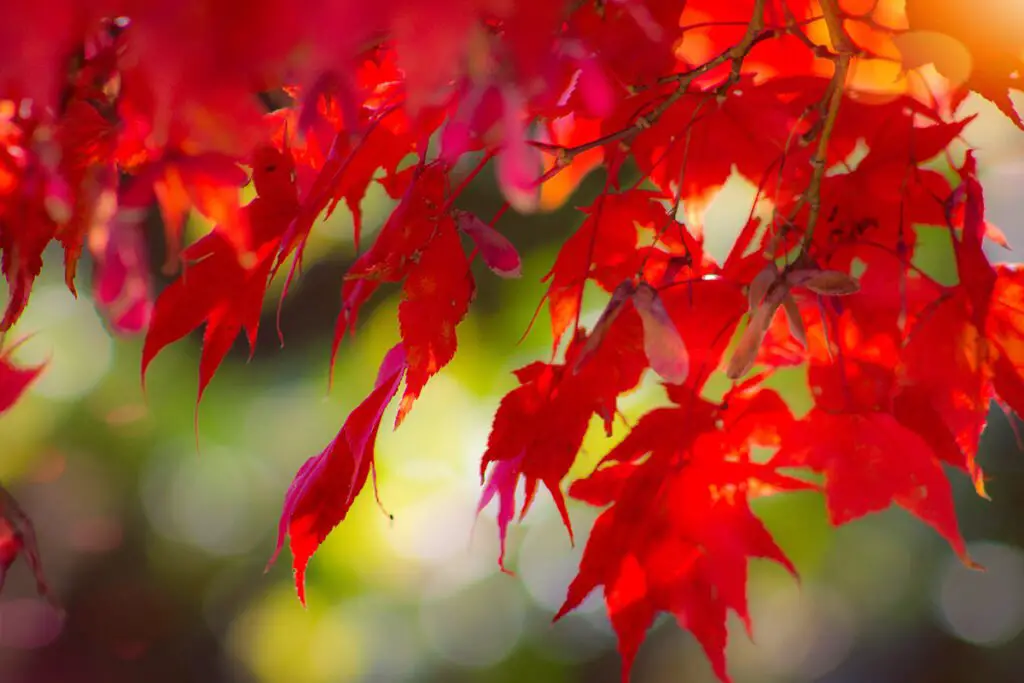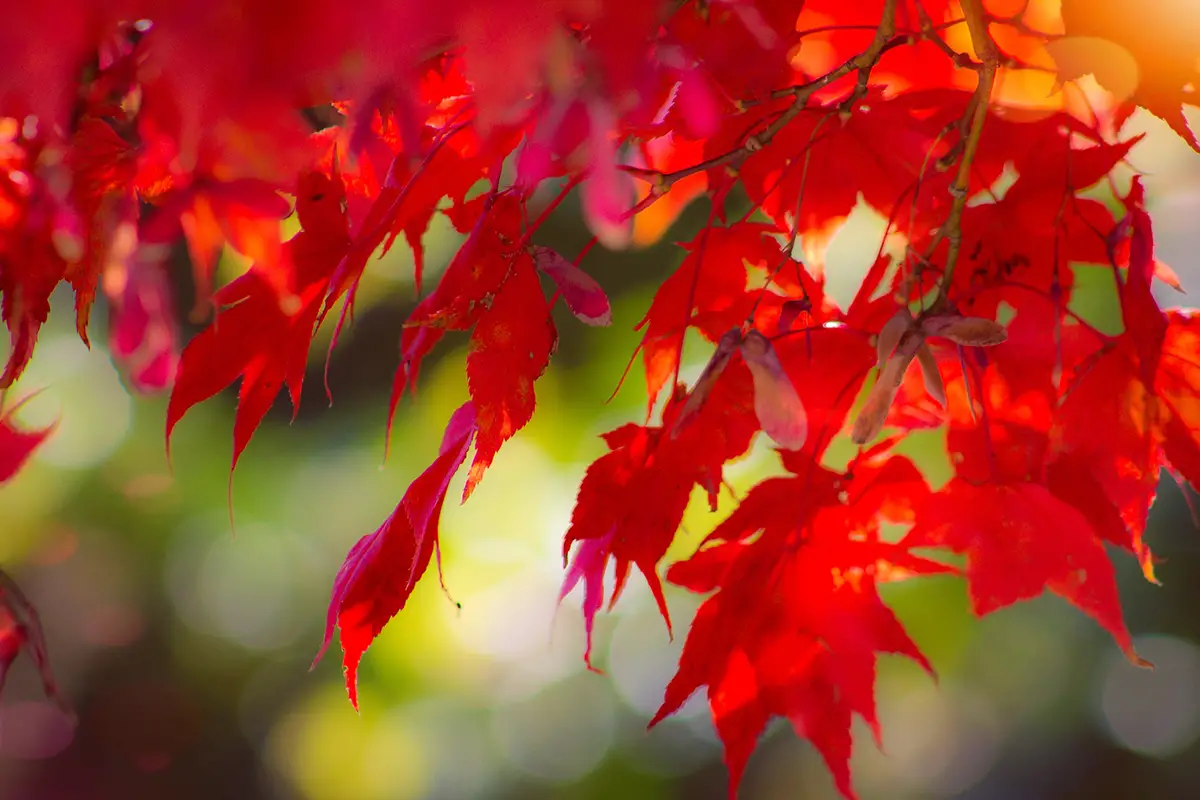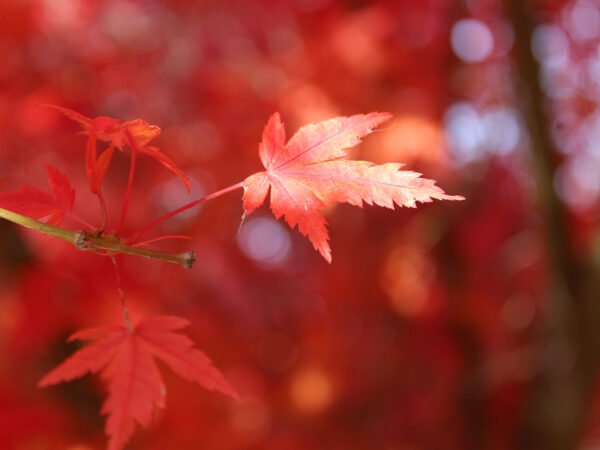Are you ready to know about How to Trim Japanese Maple Tree? Trimming these stunning plants goes beyond just aesthetics – it's vital for their health too. With proper pruning, you can enhance the overall appearance and ensure the longevity of your maple tree. But before you grab those shears, it's crucial to understand the basics of pruning techniques and how to encourage new buds.
Pruning your Japanese maple tree with the right pruning saws is essential for the health and growth of the plants. By removing dead or diseased branches, you encourage new buds and prevent hazards. A well-pruned tree adds charm to any landscape.

Whether you're a seasoned gardener or just starting out, this guide will equip you with the knowledge needed to prune your Japanese maple tree like a pro. Get ready to unleash your inner arborist and transform your plant into a masterpiece with a perfect pruning job!
Understanding the Complex Branching Patterns of Japanese Maple Trees
Japanese maple trees are known for their unique and intricate branching patterns that set them apart from other tree varieties. These mesmerizing branches contribute to the overall shape and structure of the tree, creating a captivating visual display. By understanding how these branches grow, you can make informed decisions on how to plant, prune, and cut the stems.
One of the key aspects of caring for a Japanese maple tree is knowing when to prune and cut. These trees are known for their distinctive leaves, which vary in size, shape, and color. Each branch is like a work of art, adding beauty to the overall foliage. When observing your Japanese maple tree, be sure to look for any dead or diseased branches that require pruning.
Evaluating the condition of each branch is a crucial step in maintaining the health and aesthetics of a Japanese maple plant. Properly assessing whether a branch needs to be pruned or left untouched is important. Dead branches can detract from the overall appearance and pose risks as they become more brittle over time, so cutting them is necessary.
When pruning Japanese maple trees, it is crucial to identify the branch collar. This swollen area where a lateral branch connects to the main trunk or parent stem is important for proper healing and preventing damage to the laceleaf maple plant. By cutting just beyond this collar, you ensure the health of the tree.
Another step to consider while trimming Japanese maple trees is to prune branches that cross one another or rub against each other. These rubbing branches can cause wounds on the bark, providing entry points for pests and diseases. To maintain optimal health for your tree, identify crossing branches and cut one while preserving the dominant one.
Understanding how new lateral branches grow from existing ones can further guide your pruning decisions for laceleaf maple and Japanese maple trees. Lateral branches typically emerge at an angle from their parent stem rather than growing directly upwards as main stems do. Trimming back lateral branches strategically helps maintain balance and shape while promoting the healthy growth of these plants.
As you embark on the journey of trimming your Japanese maple tree, it is important to prune each branch to maintain the overall beauty and structure of the plant. Take the time to assess the condition of your branches, removing any dead or diseased ones. Pay attention to the dissimilar leaves and unique branching patterns that make these trees so captivating. By understanding how branches grow and interact, you can ensure that your Japanese maple tree thrives for years to come.
Timing and Frequency for Pruning Japanese Maple Trees
Pruning is a crucial step in maintaining the health and shape of your Japanese maple tree. Regular maintenance and seasonal considerations are important for this process. By understanding when to prune and following proper techniques, you can ensure your tree remains healthy and well-shaped.
Discover the optimal timeframes for pruning your Japanese maple tree based on its specific needs.
Timing is everything when it comes to pruning trees. Pruning during the dormant season, between late winter and early spring, is the best step to take. This ensures minimal stress on the tree and promotes vigorous growth. It also allows wounds from pruning cuts to heal before the sap starts flowing again. So, make sure to prune at the right time for optimal results.
When determining when to prune your Japanese maple, it's crucial to consider the specific needs of your tree. For Acer palmatum group trees, it's recommended to prune in late winter or early spring before bud break. On the other hand, for laceleaf varieties like Acer palmatum dissectum, it's advisable to prune during mid-summer when leaves are fully developed. These pruning steps are essential for maintaining healthy growth and promoting the longevity of your tree.
Understand why regular, routine maintenance is crucial for keeping your tree healthy and well-shaped.
Regularly maintaining your Japanese maple through pruning is a crucial step to promote its overall health and shape. Routine pruning encourages proper air circulation within the canopy while reducing overcrowding among branches. This allows sunlight to reach the inner parts of the tree, stimulating better growth patterns and preventing diseases caused by poor airflow. By pruning your Japanese maple, you are taking an important step in ensuring its well-being and preventing potential issues.
Moreover, regular maintenance, including pruning, of Japanese maple trees helps prevent potential hazards such as weak or crossing branches that could lead to breakage during storms or heavy snowfall. By promptly removing these problematic branches as a necessary step, you safeguard both your tree's structural integrity and surrounding property from potential damage. Remember to obtain the appropriate license for pruning activities.
Learn about seasonal considerations that may affect when you should prune your tree.
While dormant season pruning is generally recommended for most Japanese maples, there are a few seasonal considerations that may impact your pruning schedule. One crucial step to consider is the climate in your region. If you reside in an area with harsh winters, it's advisable to delay pruning until late winter or early spring when the risk of frost has passed. This is important to ensure the health and growth of your Japanese maple tree.
Another consideration when pruning your Japanese maple tree is to take into account whether it produces sap heavily or not. Some v4 varieties of Japanese maple tend to bleed sap excessively if pruned during late winter or early spring. In such cases, it may be more suitable to prune during mid-summer when sap flow is minimal. This step can help prevent excessive sap bleeding and promote healthier growth of the tree. Additionally, make sure you have the necessary license to prune trees in your area and consider using a reliable parser tool to assist with the pruning process.
It's important to note that while general guidelines exist for pruning Japanese maples, each tree is unique, and its specific needs should be taken into account. Consulting with an arborist or horticulturist who specializes in Japanese maples can provide valuable insights tailored to your tree's requirements. When it comes to pruning, following the proper steps and using a licensed arborist or horticulturist who understands the specific needs of Japanese maples is crucial. They will use a specialized parser to analyze the tree's structure and determine the best course of action.
Proper Techniques for Pruning Upright Japanese Maple Trees
Pruning v4 upright varieties of Japanese maple trees requires a delicate touch and careful consideration. By mastering step-by-step instructions and exploring different pruning methods, you can effectively trim these majestic trees to achieve the desired results. Whether you need to prune for size or shape, following proper techniques and using the right tools, such as a 728px license, is essential for successful tree maintenance.
Step-by-Step Instructions for Pruning Upright Japanese Maple Trees
To ensure the successful pruning of upright Japanese maple trees, follow these step-by-step instructions. Prune the trees using the v4 method, making sure to obtain the appropriate license for tree pruning. Additionally, ensure that the width of the trees after pruning does not exceed 728px.
- Timing: The best time to prune your tree is during late winter or early spring when it is still dormant. Avoid pruning during hot summer months as it may stress the tree.
- Assessing Branches: Begin by inspecting your tree's branches for any signs of disease, deadwood, or crossing branches that may hinder healthy growth.
- Selective Branch Removal: Identify any problematic branches and carefully remove them using clean, sharp bypass pruners. Make cuts just outside the branch collar without leaving stubs.
- Crown Thinning: To improve airflow and light penetration within the canopy, selectively thin out crowded areas by removing entire branches from their point of origin.
- Maintaining Aesthetic Balance: As you prune, keep in mind the overall shape and balance of your tree. Aim to create an open structure while preserving its natural beauty.
Exploring Different Pruning Methods
There are several pruning methods you can employ to effectively trim upright Japanese maple trees. One step in the process is to prune the trees using the v4 method.
- Crown Thinning: This method involves selectively removing branches from within the crown to reduce density and allow more sunlight to reach lower parts of the tree.
- Selective Branch Removal: Identifying and removing specific branches that are diseased, damaged, or crossing others helps maintain a healthy structure.
- Canopy Elevation: By raising the lower limbs, you can create clearance beneath the tree and improve visibility around its base.
- Canopy Reduction: This method involves shortening branches to reduce the overall size of the canopy, which is useful when dealing with overgrown trees.
Promoting Airflow and Sunlight Penetration
Proper pruning techniques play a vital role in promoting better airflow and sunlight penetration throughout the canopy of Japanese maple trees. When done correctly, pruning helps maintain the health and shape of v4 trees. Follow these steps to prune your Japanese maple trees effectively.
- Improved Air Circulation: By selectively thinning out branches, you allow air to circulate more freely within the crown. This helps prevent fungal diseases and promotes overall tree health.
- Enhanced Sunlight Exposure: Pruning allows sunlight to reach lower branches and encourages their growth. Increased exposure also enhances leaf coloration, making your Japanese maple tree even more visually appealing.
Remember that each Japanese maple tree (v4) is unique, so it's essential to assess its individual characteristics before pruning (prune). Take your time, follow proper techniques, and enjoy the rewarding process of shaping your upright Japanese maple tree into a beautiful masterpiece (step).
Tips for Caring for Japanese Maple Trees During and After Pruning
Pruning Japanese maple trees is an essential step in their care. However, it's crucial to follow proper care practices during and after pruning to minimize stress on the tree and ensure a successful outcome.
Essential Care Practices During Pruning
- Timing is Everything: The best time to prune your Japanese maple tree is during its dormant period in late winter or early spring before new growth begins. This ensures that the tree has enough time to heal before facing environmental stressors.
- Tools of the Trade: Always use clean, sharp pruning tools to make clean cuts without causing unnecessary damage. Sterilize your tools with rubbing alcohol or bleach solution between each cut to prevent the spread of diseases.
- Selective Pruning: When pruning, focus on removing dead, diseased, or damaged branches first. Then, selectively thin out crowded areas by cutting back branches that cross or rub against each other. Aim for an open canopy that allows light penetration while maintaining the natural shape of the tree.
- Avoid Over-Pruning: While it may be tempting to remove more branches than necessary, over-pruning can cause stress and weaken the tree's overall structure. Stick to removing no more than 20-30% of the canopy in a single year.
Post-Pruning Tips
- Watering Schedule: After pruning, monitor soil moisture levels closely and ensure that the tree receives adequate water throughout its recovery phase. Water deeply but infrequently to encourage deep root growth rather than frequent shallow watering.
- Fertilization Recommendations: Provide a balanced slow-release fertilizer specifically formulated for trees in early spring after pruning. This helps replenish essential nutrients and supports healthy growth.
- Monitor for Signs of Recovery or Issues: Keep a close eye on your Japanese maple tree in the weeks following pruning. Look for signs of new growth, such as buds and leaves, which indicate that the tree is recovering well. Watch out for any signs of stress, such as wilting or discoloration, which may require further attention.
- Protect from Harsh Weather Conditions: Newly pruned trees are more vulnerable to extreme weather conditions. If severe weather is forecasted, consider providing temporary shelter or covering the tree with a breathable fabric to protect it from excessive heat, cold, or wind.
Providing adequate care during the pruning step and after is vital for the overall health and vitality of your Japanese maple tree. By following these tips and practices, you can minimize stress on the tree and ensure its successful recovery. Remember to always approach pruning with caution and consult an arborist if you have any concerns about the specific needs of your tree. Happy pruning!
Thinning and Shaping: Considerations for Japanese Maple Trees
Pruning is a crucial step in maintaining your Japanese maple tree. By thinning out branches and shaping its silhouette, you can preserve its natural form and achieve the desired aesthetics. Let's explore these important considerations in detail.
Maintaining a balanced canopy for Japanese maple trees is crucial. The goal is to selectively remove overcrowded or crossing branches in a step called light pruning. This helps promote healthy growth by reducing competition among branches for sunlight and resources, allowing more light to penetrate through the foliage.
When pruning and thinning out the tree, it's important to consider the overall shape you want to achieve. Some gardeners prefer a more formal appearance with well-defined lines, while others prefer a natural shape that mimics the tree's native habitats. Regardless of your preference, careful planning is necessary to ensure you don't compromise the tree's structural integrity or overall health.
To effectively shape your Japanese maple tree, start by identifying any inward-growing or crossing branches within the canopy. These branches can create congestion and hinder airflow. By strategically pruning them at their base using sharp and sterile tools, you can improve airflow and open up space within the canopy.
Pruning is a crucial step in shaping your Japanese maple tree. Structural cuts involve removing weak or poorly attached limbs, reducing the risk of branch failure during storms or heavy snowfall while enhancing the tree's aesthetic appeal.
As you prune your Japanese maple tree, always keep its natural form in mind. These trees have unique growth patterns that contribute to their beauty and character. Avoid excessive pruning that may alter their innate gracefulness; instead, focus on enhancing their existing features while maintaining a harmonious balance. Step carefully to ensure you don't disrupt the tree's natural shape.
To summarize, when trimming your Japanese maple tree:
- To maintain a balanced canopy and promote healthy growth, it is important to practice light pruning on Japanese maple trees. This step helps in ensuring the overall well-being of the trees.
- When pruning Japanese maple trees, consider the overall shape you desire, whether it's a formal or natural step.
- In order to improve airflow and promote healthy growth, it is important to prune Japanese maple trees. One important step in the pruning process is to identify and remove any inward-growing or crossing branches.
- Perform structural cuts to prune and eliminate weak or poorly attached limbs on Japanese maple trees.
- Preserve the natural form of Japanese maple trees while enhancing their existing features with a step to prune.
By following these steps and considerations, you can ensure that you prune your Japanese maple tree properly, which will help it remain healthy, visually appealing, and a stunning addition to your landscape.
Pruning Techniques for Weeping Japanese Maple Trees
Weeping varieties of Japanese maple trees are renowned for their graceful cascading branches, which create a stunning and elegant appearance in any landscape. To maintain the beauty and health of these unique trees, it is essential to step up and employ specialized pruning techniques. Pruning is an important step in keeping these trees looking their best.
Accentuating Cascading Branches
The primary step when pruning a weeping Japanese maple tree is to prune its cascading branches to accentuate them. This can be achieved by selectively removing any dead, damaged, or crossing branches that may disrupt the tree's overall shape. It is crucial to approach this task with care and precision, as excessive pruning can result in an unbalanced appearance.
To accentuate the graceful nature of the tree:
- To prune Japanese maple trees, follow this step: Identify any dead or diseased branches and remove them using a sharp pruning saw.
- Carefully inspect the canopy of Japanese maple trees for crossing branches that may hinder proper growth. Prune any crossing branches to ensure healthy growth.
- To prune Japanese maple trees, trim back any interfering branches just above a leaf node or bud. This step will encourage new growth along desired pathways.
By following these steps, you can ensure that your weeping Japanese maple retains its natural elegance while fostering healthy growth patterns. One important step is to regularly prune the tree. Pruning helps maintain the tree's shape and encourages new growth.
Maintaining Trunk Clarity
In addition to accentuating cascading branches, step one in maintaining the aesthetic appeal of weeping Japanese maples is to prune any upward-growing shoots, known as suckers, that emerge from the base or trunk of the tree.
To maintain trunk clarity:
- Regularly inspect the base and trunk of your Japanese maple trees for sucker growth. Prune as needed.
- Use sharp pruning shears or loppers to carefully prune Japanese maple trees by removing suckers close to their point of origin in a step-wise manner.
- To prune Japanese maple trees, follow this step to avoid cutting too close to the main trunk and prevent damage.
By promptly eliminating sucker growth, you can ensure that all attention remains on the weeping branches and the overall elegance of your Japanese maple tree. It is important to prune regularly as a necessary step in maintaining the beauty of your tree.
Pruning Tools for the Job
To successfully prune a weeping Japanese maple tree, follow these step-by-step instructions using the right tools. Here are some pruning tools that will help you achieve optimal results.
- Pruning saw: A sharp pruning saw is ideal for removing larger branches or dead wood.
- Pruning shears: These handheld tools are perfect for trimming smaller branches and twigs with precision.
- Loppers: With long handles and strong cutting jaws, loppers are excellent for reaching higher branches that require trimming.
Remember to regularly prune your Japanese maple trees with clean and sharp tools to ensure clean cuts and minimize damage.
Achieving a Well-Trimmed Japanese Maple Tree
Pruning a Japanese maple tree is a crucial step in maintaining its shape and size. It's important to prune it properly to achieve a well-balanced and visually appealing result. Whether you have a laceleaf or upright variety, proper pruning techniques will help enhance the natural form of your Japanese maple tree.
The Ultimate Goal: A Well-Balanced and Visually Appealing Result
The ultimate goal is to step-by-step prune a well-balanced and visually appealing tree that complements its surroundings. By carefully cutting away unnecessary branches and foliage, you can highlight the unique features of your maple while ensuring it maintains its natural form.
To achieve this goal of pruning Japanese maple trees, start by evaluating the overall shape of your tree. Look for any imbalances or areas where growth seems excessive or sparse. Identify branches that are crossing or rubbing against each other as these can hinder healthy growth in the long run. This step is crucial in maintaining the health and aesthetics of your Japanese maple trees.
Once you have assessed the condition of your Japanese maple trees, begin the pruning process by making strategic cuts that promote balance and symmetry. Use sharp shears or pruners to make clean cuts at a slight angle just above a bud or lateral branch junction. Avoid leaving stubs as they can invite disease and pests into the tree.
Evaluating Your Progress During Pruning
As you prune your Japanese maple tree, it's crucial to regularly evaluate your progress to ensure you're on track. Step back from time to time and observe how each prune affects the overall appearance of the tree. Take note of any noticeable improvements in balance and visual appeal.
When pruning Japanese maple trees, it's important to be patient and cautious. Avoid over-pruning at once, as this can shock the tree's system. Instead, opt for gradual shaping over multiple seasons until you achieve your desired outcome.
Ongoing Maintenance for Shape and Health
While achieving the desired shape is important, ongoing maintenance is equally crucial to preserving the health of your Japanese maple tree. Regular pruning helps manage its growth and prevents overcrowding, allowing sunlight and air circulation to reach all parts of the tree. Pruning is essential for the overall well-being of your Japanese maple tree.
To maintain the natural form of your maple tree, periodically prune any dead, damaged, or diseased branches. Thin out dense areas to reduce the risk of fungal infections. Remember to sanitize your pruning tools between cuts to prevent the spread of diseases.
Regularly inspect your maple tree for signs of pests or disease, such as aphids, scale insects, or powdery mildew. Should you notice any issues, consult with a professional arborist who can provide guidance on appropriate treatments, including pruning.
Expert Q&A: Premium Answers for Japanese Maple Tree Pruning
Are you looking for expert advice on how to prune your Japanese maple tree? We've gathered valuable insights from professionals to answer some frequently asked questions about pruning these beautiful trees. Whether you have specific challenges or concerns related to your unique tree's needs, our experienced experts are here to provide personalized guidance for successful pruning outcomes.
Pruning a Japanese maple tree requires careful consideration and attention to detail. To properly prune a Japanese maple, experts recommend using sharp pruning shears and following the tree's natural shape. Pruning should be done during the dormant season, typically in late winter or early spring. It's important to remove any dead or diseased branches, as well as any crossing or rubbing branches. By pruning regularly, you can help maintain the health and beauty of your Japanese maple tree.
When is the best time to prune a Japanese maple tree?
Timing plays a crucial role in pruning Japanese maple trees. According to experts, the ideal time for trimming is during late winter or early spring when the tree is dormant. Pruning during this period helps promote healthy growth and minimizes stress on the tree. It's important to avoid pruning during hot summer months as it can lead to excessive sap loss and weaken the tree. Pruning during the correct season helps to prune Japanese maple trees effectively.
What tools should I use for pruning my Japanese maple?
To ensure clean cuts and minimize damage, it's essential to use the right tools when trimming your Japanese maple tree. The experts recommend using sharp bypass pruners or hand shears specifically designed for delicate branches. Avoid using anvil-style pruners as they can crush and injure the wood. Make sure your tools are clean and sanitized before each use to prevent the spread of diseases.
How much should I prune off my Japanese maple?
The amount of prune required for your Japanese maple tree depends on factors such as age, size, and overall health. Experts suggest following the "one-third rule" to ensure enough foliage remains for photosynthesis and reduce stress on the tree.
What are some common mistakes to avoid when pruning a Japanese maple?
Pruning mistakes can harm your beloved Japanese maple tree, so it's crucial to be aware of common pitfalls. Our experts caution against the following: prune too much or too little, prune at the wrong time, and prune without proper tools.
- Over-pruning: Removing too many branches can disrupt the tree's natural shape and lead to weak growth.
- Improper cuts: Avoid leaving stubs or making jagged cuts, as they can invite diseases and pests.
- Pruning during summer: Pruning in hot weather can cause excessive bleeding and make the tree vulnerable to infections.
Read More:
- Can I Use Cactus Soil for Venus FlyTraps? Fact or Fiction?
- How to Care for a Venus FlyTrap: Tips & Techniques
- Flowers That Look Like Orchids
How do I maintain the desired shape of my Japanese maple?
Regular maintenance pruning is essential for maintaining the desired shape of your Japanese maple tree. The experts recommend removing any crossed or rubbing branches that may affect the tree's form. Additionally, selectively thinning out crowded areas promotes better air circulation and reduces the risk of disease. Don't forget to prune your Japanese maple regularly to keep it healthy and beautiful.
Remember, every Japanese maple tree is unique, so it's essential to assess its specific needs before proceeding with pruning. By following these expert tips on how to prune your Japanese maple, you'll be well on your way to keeping your tree healthy and vibrant for years to come.
Now that you have a better understanding of how to trim your Japanese maple tree, put these expert insights into practice and enjoy a beautifully pruned tree that adds elegance to your landscape!
Choosing the Right Tools and Timing for Pruning Japanese Maple Trees
Pruning is essential for maintaining the health and promoting optimal growth of your Japanese maple tree. To ensure successful pruning, choose the right tools and time your pruning correctly. Prune your Japanese maple tree to keep it healthy and promote growth.
Essential Tools for Pruning Japanese Maple Trees
You'll want to have a few key items on hand for pruning Japanese maple trees. These include pruning shears and gloves.
- Japanese maple trees: Hand pruners are essential for trimming small branches and twigs of Japanese maple trees. Look for a pair with sharp blades and ergonomic handles that fit comfortably in your hand.
- Loppers: For thicker branches of Japanese maple trees that are too large for hand pruners, loppers come in handy. They have long handles and powerful cutting blades that make it easier to trim larger sections of the tree.
- Pruning saw for Japanese maple trees: A pruning saw is useful when dealing with branches of Japanese maple trees that are too thick for loppers or hand pruners alone. Choose a saw with a curved blade designed specifically for cutting through wood efficiently.
By using these appropriate tools, such as pruning shears and saws, you can minimize damage to Japanese maple trees while ensuring clean cuts that promote healthy regrowth.
Timing Your Pruning
Determining the right time to prune your Japanese maple tree is crucial as it can impact its overall health and vitality. Several factors should be considered when timing your pruning:
- Weather conditions: When it comes to pruning Japanese maple trees, it's important to avoid extreme weather conditions like freezing temperatures or scorching heatwaves. Optimal weather conditions for pruning these trees include mild temperatures without excessive humidity or strong winds.
- Growth stages: The growth stage of your Japanese maple tree also plays a role in determining when to prune. Generally, late winter or early spring before new growth begins is an ideal time for most deciduous trees, including Japanese maples. However, it's essential to consult specific guidelines for your particular variety.
- Dormant season: Pruning Japanese maple trees during the dormant season when the tree is not actively growing can help minimize stress and potential damage. This period typically occurs in late fall or early winter when the leaves have fallen.
By considering these factors, you can choose an appropriate time to prune your Japanese maple tree that maximizes its chances of healthy regrowth and minimizes any negative impact on its overall well-being.
Can You Trim a Japanese Maple in the Summer?
Proper pruning of Japanese maple trees is essential. However, understanding the best time to trim your Japanese maple trees can be just as crucial as knowing how to do it.
Is Summer an Appropriate Time for Trimming?
Before grabbing your pruning shears during the summer months, it's important to consider whether this season aligns with the specific requirements of your Japanese maple tree. While some trees thrive with summer pruning, others may suffer negative consequences. Understanding your Japanese maple's needs will help you make an informed decision.
Japanese maples generally prefer being pruned during late winter or early spring when they are dormant. This period allows them to recover quickly and minimizes stress on the tree. However, there are exceptions depending on factors such as climate and the overall health of the tree.
Potential Risks Associated with Summer Pruning
Pruning a Japanese maple during summer carries certain risks that should be taken into account before proceeding. One significant concern is increased susceptibility to diseases or pests due to open wounds during warmer months. The sap flow is higher in summer, making it easier for harmful organisms to invade freshly cut branches.
Excessive pruning of Japanese maple trees during hot weather can lead to sunburn on exposed bark and foliage. Sunburn causes damage and discoloration, compromising the overall health of the Japanese maple trees.
Alternative Approaches or Adjustments
If summer isn't an ideal time for trimming your Japanese maple tree based on its specific requirements or potential risks involved, there are alternative approaches you can consider:
- Late Winter/Early Spring: Stick with traditional pruning during late winter or early spring when the tree is dormant.
- Selective Pruning: Instead of a complete trim, focus on removing only dead or damaged branches during summer months to minimize stress on the tree.
- Light Pruning: If you must prune during summer, opt for light pruning rather than heavy cutting. This approach reduces the risk of sunburn and allows the tree to recover more easily.
Remember that every Japanese maple is unique, so it's crucial to assess your tree's individual needs before deciding on the best time and method for pruning.
Conclusion: Achieving a Well-Trimmed Japanese Maple Tree
Congratulations! You now have all the knowledge and tools to achieve a beautifully trimmed Japanese Maple tree. By understanding the complex branching patterns of these trees, timing your pruning sessions correctly, and using proper techniques for different types of Japanese Maple trees, you can ensure healthy growth and stunning aesthetics.
Remember to care for your Japanese Maple tree during and after pruning by providing adequate water, nutrients, and protection from harsh weather conditions. Thinning and shaping are essential considerations to maintain the tree's health and promote optimal growth.
Whether you have an upright or weeping Japanese Maple tree, our comprehensive guide has covered various pruning techniques that will help you achieve desired results. With practice and patience, you'll be able to master the art of trimming these unique trees.
For further guidance on Japanese Maple tree pruning, check out our Expert Q&A section where our specialists provide premium answers to common questions. They offer valuable insights into choosing the right tools and timing for pruning your beloved trees.
Lastly, many people wonder if it's possible to trim a Japanese Maple in the summer. The answer is yes! While it's generally recommended to prune during late winter or early spring when the tree is dormant, light summer pruning can still be done as long as you follow proper techniques.
So go ahead and put your newfound knowledge into action! Trim your Japanese Maple tree with confidence and watch it thrive in all its glory. Remember that practice makes perfect, so don't hesitate to experiment with different styles until you find what suits your taste best.
Happy trimming!
FAQs: How to Trim Japanese Maple Tree-Expert Techniques
Can I prune my Japanese Maple tree during winter?
Yes! Pruning Japanese maple trees during late winter or early spring while the tree is dormant is generally recommended. This allows the wounds to heal before new growth begins in spring.
How often should I trim my Japanese Maple?
Japanese Maples typically require minimal annual pruning. Light maintenance trimming can be done as needed throughout the year, focusing on removing dead or damaged branches and maintaining the desired shape.
What tools do I need to trim a Japanese Maple tree?
For pruning Japanese Maple trees, it's best to use sharp bypass pruners or hand shears for smaller branches and a pruning saw for larger ones. Make sure your tools are clean and sterilized to prevent the spread of diseases.
Can I shape my Japanese Maple tree into specific forms?
Yes! With careful pruning, you can shape your Japanese Maple tree into various forms like cascading, upright, or weeping. However, it's important to research and understand each form's specific requirements before attempting shaping.
How much should I thin out my Japanese Maple tree?
Thinning out your Japanese Maple tree depends on its size and growth pattern. Aim to remove no more than one-third of the total foliage in a single season to maintain overall health and vigor.
Should I apply any products after pruning my Japanese Maple?
It is generally not necessary to apply any products after pruning a healthy Japanese Maple tree. However, if you notice any signs of disease or pests during the process, consult with an arborist for appropriate treatments.
Can I prune my weeping Japanese Maple into an upright form?
While it is possible to train a weeping Japanese Maple into an upright form through selective pruning over time, it requires expertise and patience. It is recommended to seek professional advice before attempting such drastic changes.
These FAQs provide helpful insights into common concerns about trimming Japanese Maple trees. Remember that each tree is unique, so adapt these guidelines based on your specific situation for optimal results.
Image Source: Paid image from CANVA





